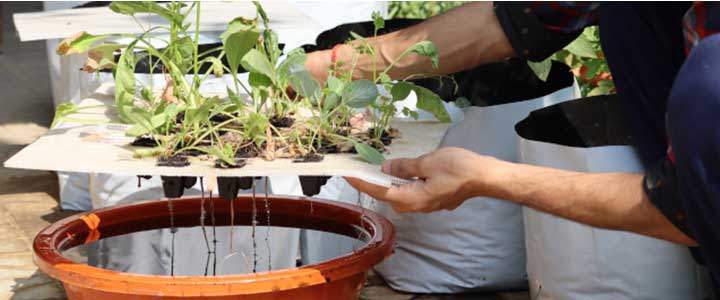
Hydroponics for Home Growers
Hydroponics for Home Growers
Setting up your hydroponic system at home is a great way to grow fresh herbs and vegetables all year round. Hydroponic growing can be incorporated into any setting and is especially useful for homes with limited space. It is an extremely efficient method of cultivating plants and is well suited for most vegetables and herbs. Utilising no soil, hydroponic systems can be installed in areas where traditional growing methods are difficult such as apartments, town houses or cottages. Hydroponic systems are easy to build yourself and can be accomplished with readily available items. In all hydroponic systems, it is important to monitor the pH and nutrient levels of the water being fed to the plant.Different methods
There are different ways to cultivate hydroponically. The biggest difference in methods will be whether they are "active" or "passive". Active systems are systems where the nutrient water is directly in contact with the plants' roots. Passive systems use an intermediate substrate that the plant is grow in with a mechanical transfer of the water. Here are some examples of popular hydroponic systems.Active hydroponic systems
Nutrient Film Technique
NFT involves pumping the water through channels or pipes to form a thin film of moving water. A bit like an artificial nutrient rich river. The plant is suspended above the water in the channel and the roots drop down directly into water. This method is recirculating and usually what most people imagine when considering hydroponics. NFT can also be used in aquaponics and is most suited to smaller vegetables and herbs.Deep Water Culture
DWC involves suspending the plant roots directly in a container of water. This water is then aerated with an air pump and airstone, and sometimes recirculated. Deep water culture is ideal for all vegetables and herbs. It is reliable and simple to set up. However, it is easier to induce unsuitable growing conditions in the water, this includes not enough oxygen or incorrect nutrient and pH levels. Careful attention should therefore be paid to water levels and conditions.Ebb and Flow
This method involves growing the plants in a bed or many pots, and the pumping the water into the tray periodically. As the water fills the tray, it introduces fresh nutrients and oxygen to the roots. Once the watering cycle is complete the water then drains back to the reservoir, usually situated beneath the tray. This method is ideally suited for larger crops and is also the choice of many aquaponic growers.Passive Systems
Hand Watering
The simplest and easiest hydroponic system you can create is a hand water system. This is just normal container growing but feeding the plant with a hydroponic nutrient solution. The plant is planted in an inert substrate such as coco coir and then watered like other pot plant. This is still considered hydroponic as the plant is being fed by the nutrient solution and no actual soil is used in the growing medium.Drip System
Similar to hand watering, this method involves container planting in an inert media and watering the plant periodically. A reservoir pump is connected to drip lines much like regular irrigation and then set on a timer for watering. Considered one of the simplest methods, this technique is often employed in commercial cultivation too. Attention should be paid to the drippers as salt build could cause blockages.Wick system
As with all passive systems, the plant is placed in an inert substrate. However instead of actively pumping the water to the plant, the substrate is suspended above or connected to the reservoir via a wick. The change in water pressure in the substrate as it dries, pulls the water through the wick from the reservoir and into the substrate. The substrate must be appropriate, and the usual choice is coco coir, however other substrates can be used. Some systems simply involve a small reservoir under each plant where others use a material wick to transport the water, much like a paraffin wick.Can I grow organic hydroponics?
The short answer is no. Organic growing requires bacteria, fungi and organic matter for the aforementioned to consume in order to feed the plant. In hydroponics for home growers there is no organic matter, only water. There are some methods and products you can use to grow "organically”; however they are expensive and difficult to maintain. The bacteria and fungi balance required for ideal growth is difficult to artificially achieve. Consider an organic soilless growing medium and passive feeding options when going this route. Here's our growing medium guide and nutrient guide for some helpful information.If organics is at the top of your priorities, you should consider aquaponics or the use of aquaculture water to feed your plants. The fish and plants create a symbiotic system where the fish excrement is broken down and consumed by the plant. In return the plant filters and cleans the water for the fish. Aquaponic systems can be installed like a regular hydroponic system and the only difference is that the fish are the source of food, not synthetic fertilizers.
Common challenges of hydroponics for home growers
There are a variety of challenges you will encounter when setting up your hydroponic system and growing in it. Different systems will have different challenges, but usually the same underlying reasons. The most common issues in hydroponics revolve around the quality of water. For the plant to grow ideally, the water must contain enough oxygen, nutrients and consistently be at the correct pH level. Often in a hydroponic system, the plant is not provided enough oxygen. Whether it be from over-watering in a passive system, or high water temperatures in an active system, growers tend to ignore the importance of oxygen saturation. Proper aeration and water temperatures are vital to ensure success.Another common problem is root-rot or disease. This is usually linked to low oxygen levels and poor hygiene in the system. Once healthy white roots will begin to appear slimy and brown while plant growth slows, sometimes resulting in death. This can be combated by maintaining a sterile environment in the water and increasing oxygen levels.
Top tips for Hydroponic Home growers
Whether you are growing hydroponically as a hobby or commercially, some things just don't change. The most important part of any hydroponic system is the water quality so you should focus on creating the best nutrient solution you can. To aid this, you should purchase a pH meter, EC meter and ORP meter. The pH meter will guide your pH adjustments, the EC meter your nutrient concentration and the ORP meter, the water sterility. Over and above these tools it is vital to maintain a clean system. Hydroponic systems are ideal places for pests and diseases to congregate. Using chemicals like diluted Hydrogen Peroxide and Hypochlorous acid will help you disinfect the system while not being too harsh on your plants.All in all, if you can only concentrate on one aspect of your hydroponic system, choose the water quality. Keeping the water cool, aerated and at the correct pH levels will prevent any major problems, even if the nutrition is not ideal. Plants are versatile organisms and can deal with a variety of stress if some basics needs are met. Over complicating a system or method could result in complete failure. Make sure you calibrate your tools regularly and K.I.S.S - Keep it simple stupid!
Need a little help making up your mind about hydroponics at home, please contact our grow pros for some top shelf advice.

Leave a comment